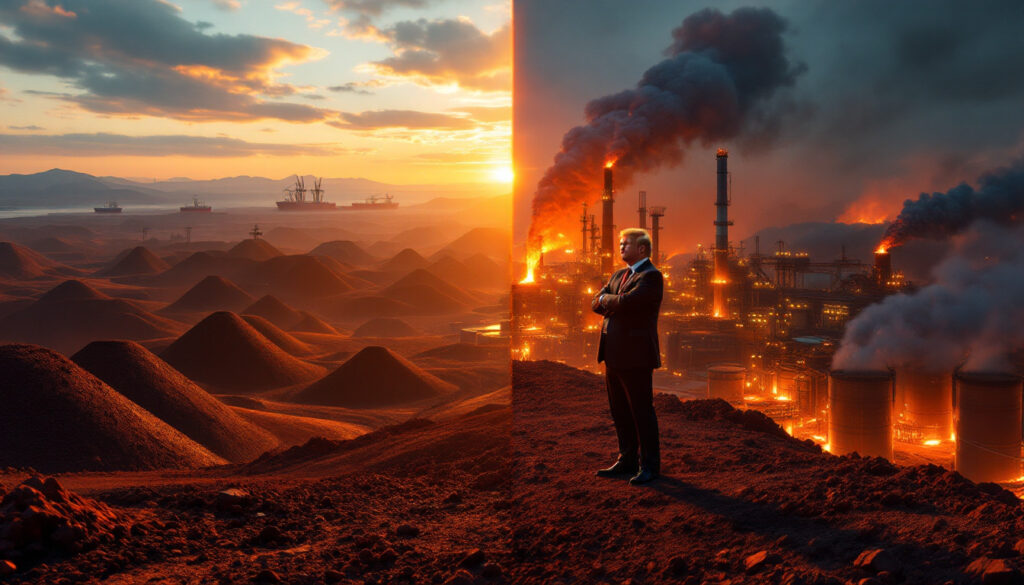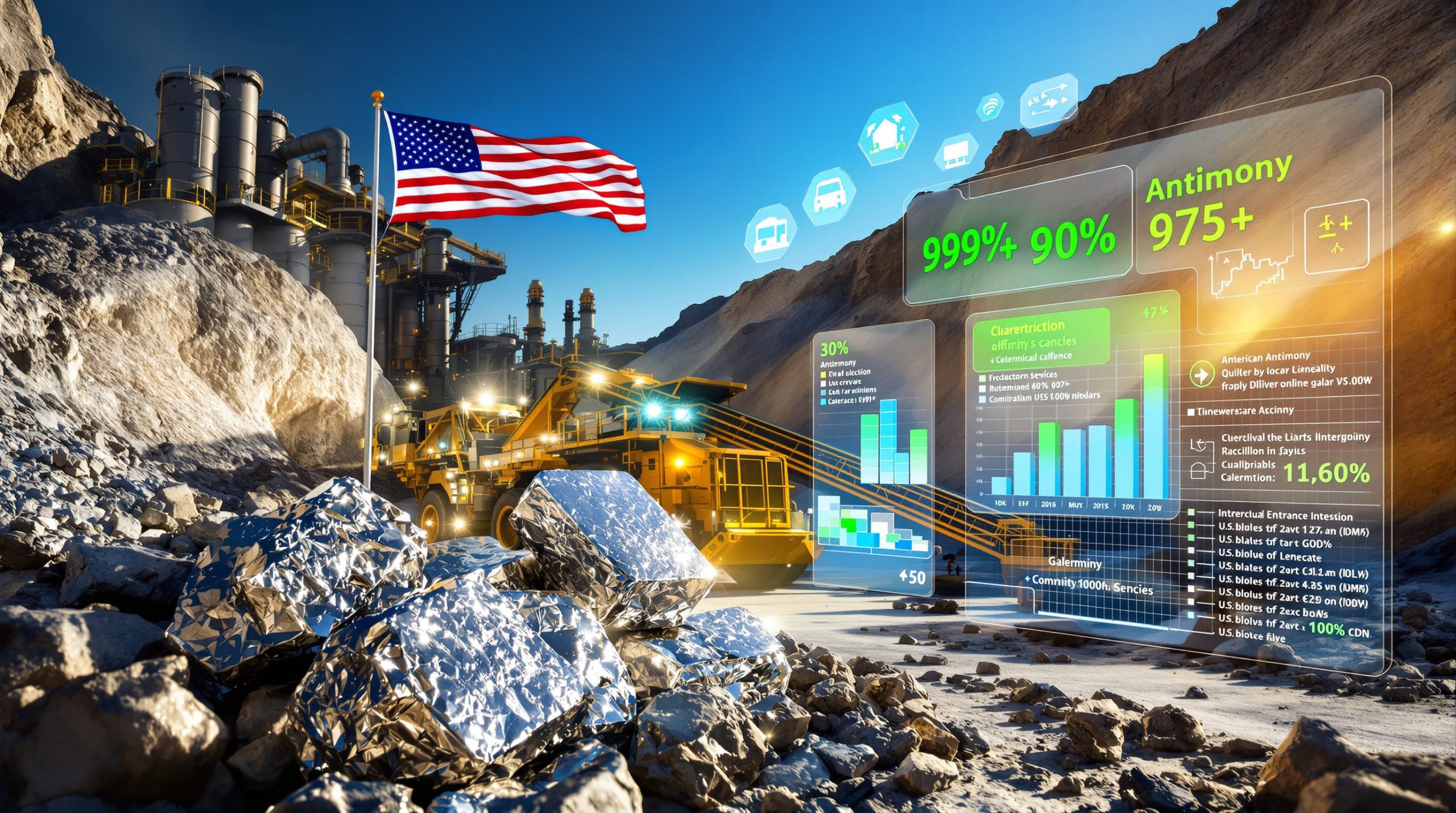How Will US Tariffs Impact the Global Iron Ore Market?
President Donald Trump's recent announcement of a "reciprocal" tariff blitz has sent ripples through global commodity markets, with iron ore particularly vulnerable to the fallout. These tariffs specifically target Chinese steel exports to key destinations including Vietnam, which now faces higher-than-expected duties on its products.
According to Goldman Sachs analysts, including Aurelia Waltham, these aggressive trade measures will significantly impact Vietnam's overseas steel sales as global growth cools. More importantly, the tariffs are expected to contribute to a broader decline in iron ore prices throughout 2025.
"The escalating trade tensions between major economies create a perfect storm for iron ore markets already dealing with supply-demand imbalances," Waltham noted in Goldman's recent market analysis.
The iron ore market has remained relatively stable over the past month, trading in a narrow range of $100-$105 per ton. However, as of April 4, 2025, iron ore futures in Singapore had slipped to $101.15 per ton, down 0.7% for the day and over 1% from the previous week. This downward trajectory aligns with Goldman's bearish outlook for the commodity.
Chinese markets were closed for a public holiday on the report date, temporarily masking the full impact of these developments on the world's largest iron ore consumer. Understanding global commodities market insights becomes crucial for investors in this complex environment.
What is Goldman Sachs Predicting for Iron Ore Prices?
Goldman Sachs has adopted an increasingly bearish stance on iron ore, predicting prices will fall below $90 per ton by the end of 2025. Their analysis suggests the market will transition into surplus during the second half of the year, potentially pushing prices as low as $84 per ton.
This forecast comes after Goldman analysts conducted an extensive on-the-ground assessment, visiting six private steel mills across China to gauge market sentiment and production plans. Their findings reveal a complex picture of the world's largest steel industry.
"While there's some near-term price support from seasonal demand patterns, our structural analysis points to significant downside risk as we enter the second half of 2025," the Goldman report states.
The investment bank's bearish outlook is supported by several key factors from their mill survey. Most notably, they forecast a substantial 15% decline in Chinese steel exports in 2025, while surveyed mills anticipate domestic demand in China to contract by up to 5% during the same period.
The market is currently weighing high Chinese mill utilization rates against impending crude steel production cuts, creating a tension that Goldman believes will ultimately resolve toward lower prices as supply outpaces demand. Investors and industry participants should consider strategies for navigating iron ore price volatility as these market dynamics unfold.
How is China Responding to Market Conditions?
China's strategic response to changing market dynamics has been multifaceted, with the China Mineral Resources Group (CMRG) playing an increasingly prominent role in stabilizing iron ore prices. This state-owned iron ore buyer has emerged as a significant market influencer through sophisticated inventory management strategies.
CMRG reportedly maintains a substantial stockpile of 10-20 million tons at Chinese ports, which it strategically deploys to counter market volatility. When supply tightens, the group releases stock into the onshore market, effectively preventing price spikes that would otherwise occur.
"CMRG's inventory strategies represent Beijing's determination to gain greater control over iron ore pricing mechanisms traditionally dominated by Australian and Brazilian producers," explains a senior commodities analyst at a Shanghai-based research firm.
On the broader geopolitical front, China's export controls on critical minerals have been implemented in direct response to US tariffs, leveraging its dominance in these resources. The country has also imposed a 34% levy on American imports as part of an escalating tit-for-tat trade war that extends well beyond steel and iron ore.
These retaliatory measures signal China's willingness to use its resource advantages as economic weapons, potentially reshaping global supply chains for various metals and minerals in the process.
What Other Global Market Impacts Are Emerging?
The US-China trade tensions have triggered a cascade of effects across commodity markets. Copper prices have plunged below $10,000 amid fears of reduced industrial demand, highlighting how trade disputes can rapidly transform market fundamentals across the metals complex.
Rare earth elements have become increasingly weaponized in the trade dispute, with China restricting exports while other nations scramble to secure alternative supplies. In a significant development, Kazakhstan recently announced the discovery of a 20-million-ton rare earth metals deposit, potentially altering global supply dynamics for these critical minerals.
"The Kazakhstan discovery, while substantial, will take years to develop into commercial production. Nevertheless, it represents the kind of supply diversification Western nations are desperately seeking," notes a mining sector analyst specializing in critical minerals.
The United States has signaled it's considering launching critical minerals tariff probes, further politicizing supply chains that were once governed primarily by market forces.
For mining companies, these geopolitical pressures are creating unprecedented challenges. Glencore is reportedly seeking an Australian government bailout for its local copper assets, while companies like Kodal Minerals are pushing forward with lithium projects despite market uncertainties.
"We're witnessing a fundamental shift in how mining operations evaluate political risk," explains a mining finance specialist. "The nationalistic approach to resource security is replacing decades of globalized mineral trade patterns."
The Outlook for Iron Ore Markets Through 2025
Goldman's bearish view on iron ore reflects structural changes in the market beyond just US tariffs. China's steel sector is undergoing a transition toward higher efficiency and lower emissions, which ultimately means reduced iron ore consumption per unit of economic output.
Chinese steel mills are increasingly adopting electric arc furnace (EAF) technology that utilizes scrap steel rather than iron ore. This technological shift, combined with weaker construction demand in China's property sector, creates a fundamental headwind for iron ore pricing.
"The days of $150+ iron ore driven by China's insatiable appetite for steel are likely behind us," notes a veteran commodities trader. "We're entering a new era where $80-90 per ton might represent a more sustainable equilibrium."
For mining giants like BHP, Rio Tinto, and Vale, this new price environment necessitates operational discipline and cost management. The major producers continue to generate healthy cash flows even at lower price points, but the super-profits of recent commodity supercycles are increasingly unlikely. Disruptions such as cyclones in Australia's iron ore regions can lead to significant impacts on global iron ore supply chains, adding another layer of complexity to price forecasting.
Strategic Implications for Investors and Industry Participants
Market participants should prepare for increased iron ore price volatility as trade tensions, supply fluctuations, and China's inventory management strategies create a complex trading environment. While Goldman predicts a downward trajectory, short-term rallies remain possible during seasonal demand peaks or supply disruptions.
For steel producers outside China, the combination of US tariffs and reduced Chinese exports creates a mixed outlook. While protection from Chinese competition may benefit local producers, higher input costs and potential demand destruction could offset these advantages.
Investors in mining equities should carefully evaluate company exposure to iron ore versus diversification into other minerals. Those miners with significant copper, nickel, and lithium operations may offer better risk-adjusted returns as the energy transition continues despite trade headwinds.
"The winners in this environment will be low-cost producers with strong balance sheets and operational flexibility," suggests a mining equity analyst. "Companies that can quickly adjust production to market conditions while maintaining cost discipline will outperform."
According to a recent report from Mining.com, the US tariff announcements have created additional downward pressure on iron ore markets already facing structural challenges. Understanding market dynamics becomes essential for investors navigating these uncertain conditions.
FAQ: US Tariffs and Iron Ore Market
How much will iron ore prices fall according to Goldman Sachs?
Goldman Sachs predicts iron ore prices will fall below $90 per ton by the end of 2025, potentially reaching as low as $84 per ton as the market moves into surplus in the second half of the year.
What percentage decline is expected in Chinese steel exports?
Goldman Sachs forecasts Chinese steel exports will fall by approximately 15% in 2025, with surveyed mills expecting domestic demand to decline by as much as 5%.
How is China's state-owned iron ore buyer influencing the market?
China Mineral Resources Group is reportedly holding 10-20 million tons of inventory at ports and strategically selling stock in the onshore market when supply becomes tight, which helps reduce market volatility.
What retaliatory measures has China implemented against US tariffs?
China has placed export restrictions on key rare earth elements and imposed a 34% levy on American imports as part of its response to President Trump's tariff announcements.
Looking to Stay Ahead of Major Mineral Discoveries?
Discovery Alert's proprietary Discovery IQ model transforms complex ASX announcements into actionable investment insights, giving you a critical edge in identifying significant mineral discoveries before the broader market. Visit our dedicated discoveries page to see how historic discoveries have generated substantial returns for early investors.




